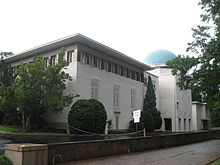Embassy of Iran, Washington, D.C.
The Former Embassy of Iran in Washington, D.C. was the Imperial State of Iran's diplomatic mission to the United States. Direct bilateral Iran–United States relations between the two governments were severed following the Iranian Revolution in 1979, and the subsequent seizure of hostages at the U.S. Embassy in Tehran, Iran.
| Embassy of Iran | |
|---|---|
 | |
 | |
| Location | Washington, D.C. |
| Address | 3003–3005 Massachusetts Avenue, N.W. |
| Coordinates | 38°55′11″N 77°3′36″W / 38.91972°N 77.06000°W |
| Ambassador | Ardeshir Zahedi (last) |
History
editThe chancery, a modernist building, was built in 1959. It is accompanied by a Georgian style structure that serves as the ambassador's residence.[1] The complex is located in Washington, D.C.'s Embassy Row neighborhood.
During the age of the Shah, he attended numerous embassy functions there. The last resident Ambassador, Ardeshir Zahedi, cultivated a reputation of opulence, with star-studded parties and dinners. Famous figures who visited the embassy include Elizabeth Taylor, Andy Warhol, Barbara Walters, and Frank Sinatra. This was documented in 2013 by Iranian-American artist Eric Parnes, the first person in over 34 years to photograph the interior of the embassy.[2]
The embassy complex continues to be de jure owned by the Government of Iran,[3][4] but it has not been used by the Iranian government since April 7, 1980, and its buildings and grounds are currently maintained and de facto controlled by the U.S. Department of State.[5] Other properties include the residence of the Iranian military attache, 3410 Garfield Street NW, and the residence of the Iranian Minister of Cultural Affairs, 2954 Upton Street NW. Six of ten buildings are being rented.[6][7]
Iranian Interest Section of the Pakistani Embassy
editIran is now represented diplomatically through the Interests Section of the Islamic Republic of Iran in the United States located in the Pakistani Embassy.[8][9]
See also
editReferences
edit- ^ "Iran's govt buildings in DC are vacant. But they're full of stories". The World from PRX. Retrieved 2021-06-02.
- ^ Bahrampour, Tara (December 8, 2013). "The Iranian embassy shuttered for decades was known for hedonistic star studded gatherings". The Washington Post.
- ^ "3003 Massachusetts Avenue NW". Property Detail. Office of Tax and Revenue. Government of the District of Columbia. Retrieved May 14, 2018.
- ^ "3005 Massachusetts Avenue NW Archived 2021-12-04 at the Wayback Machine". Property Detail. Office of Tax and Revenue. Government of the District of Columbia. Retrieved May 14, 2018.
- ^ "US is protecting former Iranian embassy building in DC". Jerusalem Post. January 12, 2011. Archived from the original on 2012-10-23.
- ^ Fandos, Nicholas (September 23, 2016). "$12 Million Iranian Embassy Is Empty, but the U.S. Cuts the Grass". The New York Times.
- ^ "Former Embassy of the Islamic Republic of Iran, Washington Archived 2017-05-05 at the Wayback Machine". virtualglobetrotting.com. May 16, 2006.
- ^ Luxner, Larry (November 2001). "Despite Lack of Diplomatic Ties, Door to Iran is Slowly Opening". The Washington Diplomat. Archived from the original on 2011-09-09. Retrieved 2017-12-04.
The only difference is that the Cubans have their own office, which used to be the Cuban Embassy before their revolution. We don't have our own office, because the State Department has kept our embassy, and likewise, the Iranian government has the U.S. Embassy in Tehran.
- ^ "Congressmen Pay A Visit to the Iranian Interest Section". The Weekly Standard. 4 February 2016. Archived from the original on February 5, 2016.
Unlike the grand embassies of Washington, Pakistan's embassy is a nondescript brick building downtown that looks like it could house any number of commercial enterprises. Inside, the Iranian Interest Section has a cramped lobby underneath a staircase that keeps the rest of the Interest Section out of sight.
External links
edit- "The iranian embassy shuttered for decades was known for hedonistic star studded gatherings", "Washington Post", December 8, 2013
- "U.S. "Respects and Protects" Former Iranian Embassy", International Information Programs digital, Jane Morse, 26 October 2011
- "Recalling Iran's former Embassy in Washington", The Polyglot, January 23, 2011
- "Newsline: US is protecting former Iranian embassy building in DC", Diplomatic Briefing, January 12, 2011
- Former Embassy of Iran, Wikimapia
- https://www.flickr.com/photos/albinoflea/531708419/
- wikimapia